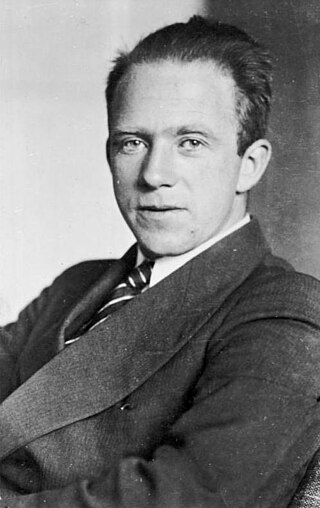
Werner Karl Heisenberg was a German theoretical physicist, one of the main pioneers of the theory of quantum mechanics, and a principal scientist in the Nazi nuclear weapons program during World War II. He published his Umdeutung paper in 1925, a major reinterpretation of old quantum theory. In the subsequent series of papers with Max Born and Pascual Jordan, during the same year, his matrix formulation of quantum mechanics was substantially elaborated. He is known for the uncertainty principle, which he published in 1927. Heisenberg was awarded the 1932 Nobel Prize in Physics "for the creation of quantum mechanics".
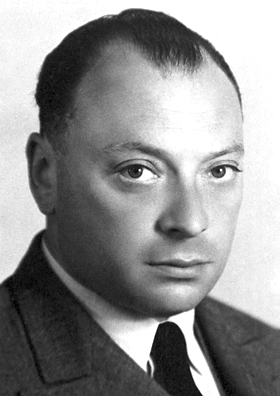
Wolfgang Ernst Pauli was an Austrian theoretical physicist and one of the pioneers of quantum physics. In 1945, after having been nominated by Albert Einstein, Pauli received the Nobel Prize in Physics for his "decisive contribution through his discovery of a new law of Nature, the exclusion principle or Pauli principle". The discovery involved spin theory, which is the basis of a theory of the structure of matter.
Synchronicity is a concept first introduced by analytical psychologist Carl G. Jung "to describe circumstances that appear meaningfully related yet lack a causal connection." In contemporary research, synchronicity experiences refer to one's subjective experience whereby coincidences between events in one's mind and the outside world may be causally unrelated to each other yet have some other unknown connection. Jung held that this was a healthy, even necessary, function of the human mind that can become harmful within psychosis.

Arnold Johannes Wilhelm Sommerfeld, was a German theoretical physicist who pioneered developments in atomic and quantum physics, and also educated and mentored many students for the new era of theoretical physics. He served as doctoral supervisor and postdoc supervisor to seven Nobel Prize winners and supervised at least 30 other famous physicists and chemists. Only J. J. Thomson's record of mentorship offers a comparable list of high-achieving students.

Analytical psychology is a term coined by Carl Jung, a Swiss psychiatrist, to describe research into his new "empirical science" of the psyche. It was designed to distinguish it from Freud's psychoanalytic theories as their seven-year collaboration on psychoanalysis was drawing to an end between 1912 and 1913. The evolution of his science is contained in his monumental opus, the Collected Works, written over sixty years of his lifetime.
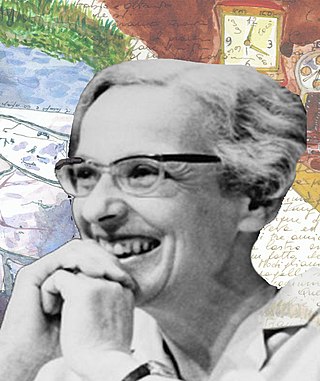
Marie-Louise von Franz was a Swiss Jungian psychologist and scholar, known for her psychological interpretations of fairy tales and of alchemical manuscripts.

Paul Hermann Scherrer was a Swiss physicist. Born in St. Gallen, Switzerland, he studied at Göttingen, Germany, before becoming a lecturer there. Later, Scherrer became head of the Department of Physics at ETH Zurich.

Sir Rudolf Ernst Peierls, was a German-born British physicist who played a major role in Tube Alloys, Britain's nuclear weapon programme, as well as the subsequent Manhattan Project, the combined Allied nuclear bomb programme. His 1996 obituary in Physics Today described him as "a major player in the drama of the eruption of nuclear physics into world affairs".
Ernst Carl Gerlach Stueckelberg was a Swiss mathematician and physicist, regarded as one of the most eminent physicists of the 20th century.

Hans Bender was a German lecturer on the subject of parapsychology, who was also responsible for establishing the parapsychological institute Institut für Grenzgebiete der Psychologie und Psychohygiene in Freiburg. For many years his pipe smoking, contemplative figure was synonymous with German parapsychology. He was an investigator of 'unusual human experience', e.g. poltergeists and clairvoyants. One of his most famous cases was the Rosenheim Poltergeist.

Carl Gustav Carus was a German physiologist and painter, born in Leipzig, who played various roles during the Romantic era. A friend of the writer Johann Wolfgang von Goethe, he was a many-sided man: a doctor, a naturalist, a scientist, a psychologist, and a landscape painter who studied under Caspar David Friedrich.

In the philosophy of mind, double-aspect theory is the view that the mental and the physical are two aspects of, or perspectives on, the same substance. It is also called dual-aspect monism, not to be confused with mind–body dualism. The theory's relationship to neutral monism is ill-defined,
Neutral monism and the dual-aspect theory share a central claim: there is an underlying reality that is neither mental nor physical. But that is where the agreement stops. Neutral monism has no room for the central feature of the dual-aspect theory: the mental and physical aspects, sides, or properties that characterize the underlying entities of dual-aspect theory. The neutral monist accepts the mental/physical distinction.
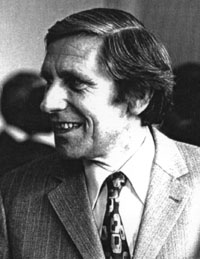
Harry Lehmann was a German physicist.

The Reichsuniversität Straßburg was founded in 1941 by the Nazis in Alsace after the annexation of Alsace-Lorraine by Nazi Germany. The University of Strasbourg had moved to Clermont-Ferrand in 1939. The university's purpose was to restore the German character of the Kaiser-Wilhelm-Universität, as the University of Strasbourg was named from 1872 to 1918, and to advance "German knowledge" in the annexed territory. When the Allies arrived in Alsace in 1944, the Reichsuniversität was first transferred to Tübingen and then dissolved.
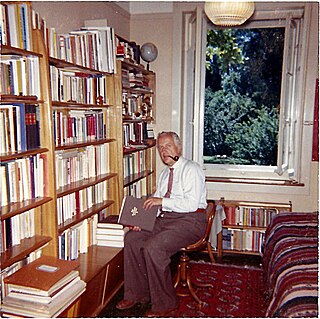
Hans Martin Sutermeister was a Swiss physician and medical writer, politician, and activist against miscarriages of justice.

This is a list of writings published by Carl Jung. Many of Jung's most important works have been collected, translated, and published in a 20-volume set by Princeton University Press, entitled The Collected Works of C. G. Jung. Works here are arranged by original publication date if known.
"Not even wrong" is a phrase often used to describe pseudoscience or bad science. It describes an argument or explanation that purports to be scientific but uses faulty reasoning or speculative premises, which can be neither affirmed nor denied and thus cannot be discussed rigorously and scientifically. The phrase "not even wrong" is synonymous with "unfalsifiable".
Aniela Jaffé was a Swiss analyst who for many years was a co-worker of Carl Gustav Jung. She was the recorder and editor of Jung's semi-autobiographical book Memories, Dreams, Reflections.

Emil Karl Gustav Alfred Mattiesen was a Baltic Germans musician, music pedagogue, composer and philosopher. He composed lieder, song cycles, ballads, chamber music and organ music, but is better known for standard works in German on parapsychology. He was a professor of church music at the University of Rostock from 1929.
Charles Paul Enz is a Swiss theoretical physicist, known for his long association with Wolfgang Pauli.















